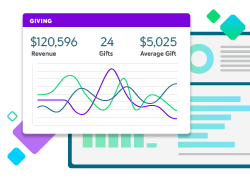What Are Passive Fundraisers? FAQ + 4 Ideas for Nonprofits

As a nonprofit professional, you’re probably always looking for innovative fundraising ideas for your organization. Most nonprofits host several fundraising events and giving campaigns throughout the year, which bring in lots of revenue but require extensive planning and have upfront costs.
Passive fundraisers are a great way to supplement the funds you raise from events and campaigns. Besides being convenient for supporters, they’re easy to run, and many can be set up at little to no cost to your organization.
In this guide, we’ll answer some frequently asked questions about passive fundraisers and suggest four passive fundraising ideas for your nonprofit to consider adding to your revenue model. Let’s dive in!
Passive Fundraising: Frequently Asked Questions
While passive fundraisers are generally easy to run, the name is somewhat misleading because they don’t take a “set-it-and-forget-it” approach. To understand the idea more accurately, let’s look at three commonly asked questions about passive fundraising:
What is a passive fundraiser?
ShopRaise’s guide to passive fundraising defines the term as a way for supporters to contribute to nonprofits as they go about their daily lives. In many cases, they’ll make everyday purchases where a portion of the proceeds go back to your organization. These fundraisers are convenient both for your supporters and for your nonprofit.
How does passive fundraising work?
Once your organization sets up a passive fundraiser, the process of actually running it is fairly hands-off. However, your fundraising will only be successful if you actively communicate with your supporters.
First, your organization needs to spread the word about the fundraiser by leveraging multiple marketing channels, such as:
- Your nonprofit’s website
- Email marketing
- Social media
- Direct mail
When your passive fundraiser is underway, you’ll track your fundraising results, make adjustments to your marketing strategy, and thank your donors for their contributions.
How do passive fundraisers fit into a nonprofit’s fundraising strategy?
In many cases, passive fundraisers can provide year-round revenue for your organization. Nonprofits tend to bring in the most donations at the end of the calendar year and experience a lull during the summer, but passive fundraising is effective no matter what month it is. Plus, diversifying your revenue streams allows your nonprofit to build a more sustainable fundraising model.
4 Passive Fundraising Ideas
Now that you know how these types of fundraisers work, here are four of the top passive fundraising ideas to consider for your nonprofit:
1. Online Shopping Fundraisers
Online shopping fundraisers allow supporters to contribute to your nonprofit as they make everyday purchases from participating retailers. When your organization partners with a shopping fundraiser program, you’ll receive a portion of supporters’ total sales at no additional cost to you or the shopper.
Your nonprofit can get started with an online shopping fundraiser in three easy steps:
- Sign up for a shopping fundraiser program. This program has access to a wide network of retailers that your supporters likely already shop at and will handle all necessary business negotiations for you.
- Spread the word to your supporters. Many of your supporters won’t have participated in a shopping fundraiser before, so they’ll need instructions to get started. The shopping fundraiser program can also create branded marketing materials to help your nonprofit remind supporters to continue shopping for your cause over time.
- Track your fundraising results. With the right program, you’ll be able to view real-time data on your fundraiser so you can easily recognize your top supporters and make improvements to your marketing strategy.
When supporters shop for your cause, they’ll pay the same prices for items and have access to the same discounts they would have otherwise. The only difference is that they’ll use the shopping fundraiser program’s app or browser extension to make their purchases. Over time, their small contributions will add up to make a major difference for your nonprofit!
2. Restaurant Partnerships
Many restaurants will partner with nonprofits to hold passive fundraisers. When deciding which restaurants to form a partnership with, your nonprofit generally has two options:
- Contact a locally owned restaurant. Since local businesses rely heavily on community support, they’re often eager to partner with nonprofits in their area. This strategy works well for nonprofits of all sizes, but you’ll have to negotiate the partnership agreement yourself.
- Apply to partner with a large restaurant chain. Panera Bread, Chipotle, and Panda Express are just three of the many chain restaurants that support nonprofits through their corporate philanthropy programs. These partnership processes are more streamlined than local businesses’, but chains often don’t accept applications from small organizations.
Some restaurant partners will set up a donation box by their register or ask customers to round up their total sales to donate to your nonprofit. But in many cases, the restaurant will contribute through a profit sharing model, so they’ll donate an agreed-upon portion of their profits on a given day. Make sure to communicate with your supporters well in advance so they’ll remember to eat at that restaurant on the right day.
3. Charity Affiliate Programs
Charity affiliate programs fall into the broader category of affiliate marketing. This system involves individuals or organizations promoting a business’s products through digital marketing platforms in exchange for commissions. If your nonprofit is active on social media and has a strong web presence, you’re in a great position to bring in revenue through an affiliate program.
There are a variety of charity affiliate programs your organization could join, so do your research to find a partner whose values align with yours. Also, try to choose a business that sells products with widespread appeal to maximize supporter involvement and, therefore, your commissions.
4. Matching Gifts
Matching gifts allow your organization to essentially double many of the individual donations you bring in. When a supporter who works for a company with a matching gift program contributes to your organization and submits a match request, their employer will match their donation, usually at a 1:1 ratio. Some matching gift tools even have auto-submission functionality, which makes the match request process even more streamlined for your donors and your nonprofit.
As with other passive fundraisers, marketing is critical to reaping the benefits of matching gifts. This is mainly true because many eligible donors aren’t aware that their employers have matching gift programs. To solve this problem, create a dedicated matching gifts page on your organization’s website, send out emails explaining the matching process, and post reminders on social media for supporters to check their eligibility.
Passive fundraisers are easy for supporters to participate in and for your nonprofit to run, besides being innovative and reliable revenue sources. Just remember that while the fundraiser itself is passive, your marketing and data analysis need to be active. Do your research and develop strategic partnerships to make your passive fundraisers as successful as possible. Happy fundraising!
The Nonprofit CRM Built for Fundraisers
Find out how Blackbaud’s Raiser’s Edge NXT® fits your organization.





